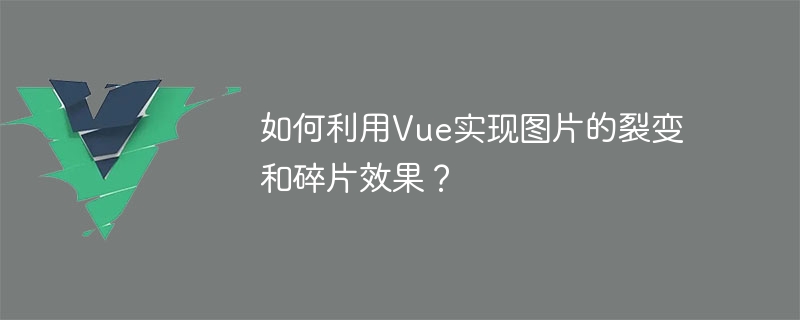

How to use Vue to achieve the fission and fragmentation effects of images?
In front-end development, it is often necessary to add some special effects to web pages to enhance the user experience. Among them, the fission and fragmentation effects of pictures are one of the more common special effects. This article will introduce how to use the Vue framework to achieve the fission and fragmentation effects of images, and attach relevant code examples.
assets folder and reference them in components. template, you can use the <img alt="How to use Vue to achieve the fission and fragmentation effects of images?" > tag to display images. At the same time, in order to achieve fission and fragmentation effects, we need to define some status values in data to control the display of animation effects. <template>
<div>
<img :src="imageUrl" : style="max-width:90%" alt="" />
<div class="particles" :style="particleStyle" v-if="showParticles"></div>
</div>
</template>
<script>
export default {
data() {
return {
imageUrl: require('@/assets/image.jpg'), // 替换成你的图片地址
imageStyle: {
width: '500px', // 根据图片大小设置宽度
height: 'auto', // 根据图片宽高比计算高度
position: 'relative',
},
particleStyle: {
position: 'absolute',
width: '10px',
height: '10px',
background: 'red', // 碎片的颜色
},
showParticles: false, // 是否展示碎片
}
},
mounted() {
// 设置一个定时器,在3秒后展示碎片效果
setTimeout(() => {
this.showParticles = true;
}, 3000);
},
}
</script>
<style scoped>
.particles {
width: 100%;
height: 100%;
overflow: hidden;
}
</style>canvas in the mounted hook to process the image. The specific steps are as follows: canvas element and set the same width and height as the image. canvas and use the drawImage method to draw the image onto canvas. getImageData method to obtain the pixel data of the image, and then process each pixel. fillRect method to draw small rectangles on the canvas to form a fission effect. The following is a code example of the fission effect:
<template>
<div>
<canvas ref="canvas" :width="canvasWidth" :height="canvasHeight" />
<div class="particles" :style="particleStyle" v-if="showParticles"></div>
</div>
</template>
<script>
export default {
data() {
return {
imageUrl: require('@/assets/image.jpg'), // 替换成你的图片地址
imageStyle: {
width: '500px', // 根据图片大小设置宽度
height: 'auto', // 根据图片宽高比计算高度
position: 'relative',
},
particleStyle: {
position: 'absolute',
width: '10px',
height: '10px',
background: 'red', // 碎片的颜色
},
canvasWidth: 500,
canvasHeight: 0,
showParticles: false, // 是否展示碎片
}
},
mounted() {
const canvas = this.$refs.canvas;
const ctx = canvas.getContext('2d');
const img = new Image();
img.src = this.imageUrl;
img.onload = () => {
this.canvasHeight = (img.height * this.canvasWidth) / img.width;
canvas.width = this.canvasWidth;
canvas.height = this.canvasHeight;
ctx.drawImage(img, 0, 0, this.canvasWidth, this.canvasHeight);
const imageData = ctx.getImageData(0, 0, this.canvasWidth, this.canvasHeight);
const pixels = imageData.data;
// 对每个像素进行处理
for (let i = 0; i < pixels.length; i += 4) {
const r = pixels[i];
const g = pixels[i + 1];
const b = pixels[i + 2];
const a = pixels[i + 3];
const x = (i / 4) % this.canvasWidth;
const y = Math.floor(i / 4 / this.canvasWidth);
if (Math.random() < 0.5) {
ctx.fillStyle = `rgba(${r},${g},${b},${a / 255})`;
ctx.fillRect(x, y, 1, 1);
}
}
// 定时器,在3秒后展示碎片效果
setTimeout(() => {
this.showParticles = true;
}, 3000);
};
},
}
</script>data Define some variables to control the number and position of fragments. Then, use a v-for loop in the mounted hook to generate the fragments and set their position and animation. The following is a code example for the fragmentation effect:
<template>
<div>
<canvas ref="canvas" :width="canvasWidth" :height="canvasHeight" />
<div class="particles" v-if="showParticles">
<div
class="particle"
:class="'particle-' + index"
v-for="(particle, index) in particles"
:key="index"
:style="{ left: particle.x + 'px', top: particle.y + 'px', animationDelay: particle.delay + 'ms' }"
></div>
</div>
</div>
</template>
<script>
export default {
data() {
return {
imageUrl: require('@/assets/image.jpg'), // 替换成你的图片地址
imageStyle: {
width: '500px', // 根据图片大小设置宽度
height: 'auto', // 根据图片宽高比计算高度
position: 'relative',
},
particleStyle: {
position: 'absolute',
width: '10px',
height: '10px',
background: 'red', // 碎片的颜色
},
canvasWidth: 500,
canvasHeight: 0,
showParticles: false, // 是否展示碎片
particles: [], // 碎片数组
}
},
mounted() {
const canvas = this.$refs.canvas;
const ctx = canvas.getContext('2d');
const img = new Image();
img.src = this.imageUrl;
img.onload = () => {
this.canvasHeight = (img.height * this.canvasWidth) / img.width;
canvas.width = this.canvasWidth;
canvas.height = this.canvasHeight;
ctx.drawImage(img, 0, 0, this.canvasWidth, this.canvasHeight);
const imageData = ctx.getImageData(0, 0, this.canvasWidth, this.canvasHeight);
const pixels = imageData.data;
// 对每个像素进行处理
for (let i = 0; i < pixels.length; i += 4) {
const r = pixels[i];
const g = pixels[i + 1];
const b = pixels[i + 2];
const a = pixels[i + 3];
const x = (i / 4) % this.canvasWidth;
const y = Math.floor(i / 4 / this.canvasWidth);
if (Math.random() < 0.5) {
ctx.fillStyle = `rgba(${r},${g},${b},${a / 255})`;
ctx.fillRect(x, y, 1, 1);
}
}
// 初始化碎片数组
for (let i = 0; i < 1000; i++) {
const x = Math.random() * this.canvasWidth;
const y = Math.random() * this.canvasHeight;
const delay = Math.random() * 2000;
this.particles.push({
x,
y,
delay,
});
}
// 定时器,在3秒后展示碎片效果
setTimeout(() => {
this.showParticles = true;
}, 3000);
};
},
}
</script>
<style scoped>
.particles {
width: 100%;
height: 100%;
overflow: hidden;
}
.particle {
position: absolute;
width: 10px;
height: 10px;
background: red; // 碎片的颜色
animation: particle-fade 2s ease-in-out infinite;
}
@keyframes particle-fade {
0% {
opacity: 1;
transform: translateY(0);
}
50% {
opacity: 0;
transform: translateY(20px);
}
100% {
opacity: 1;
transform: translateY(0);
}
}
.particle-0 {
animation-delay: 50ms;
}
.particle-1 {
animation-delay: 100ms;
}
.particle-2 {
animation-delay: 150ms;
}
/* ... */
</style>Through the above code example, we can easily achieve the fission and fragmentation effects of images in Vue. When the page loads, the image will first break into fragments, and then after a period of animation, the complete image will finally be displayed. You can adjust the parameters in the code according to actual needs to achieve the effect you want.
I hope this article can help you understand the implementation of image fission and fragmentation effects in Vue!
The above is the detailed content of How to use Vue to achieve the fission and fragmentation effects of images?. For more information, please follow other related articles on the PHP Chinese website!